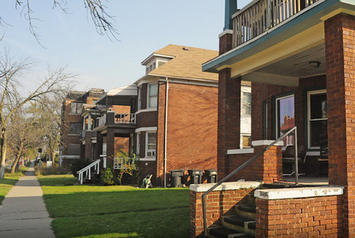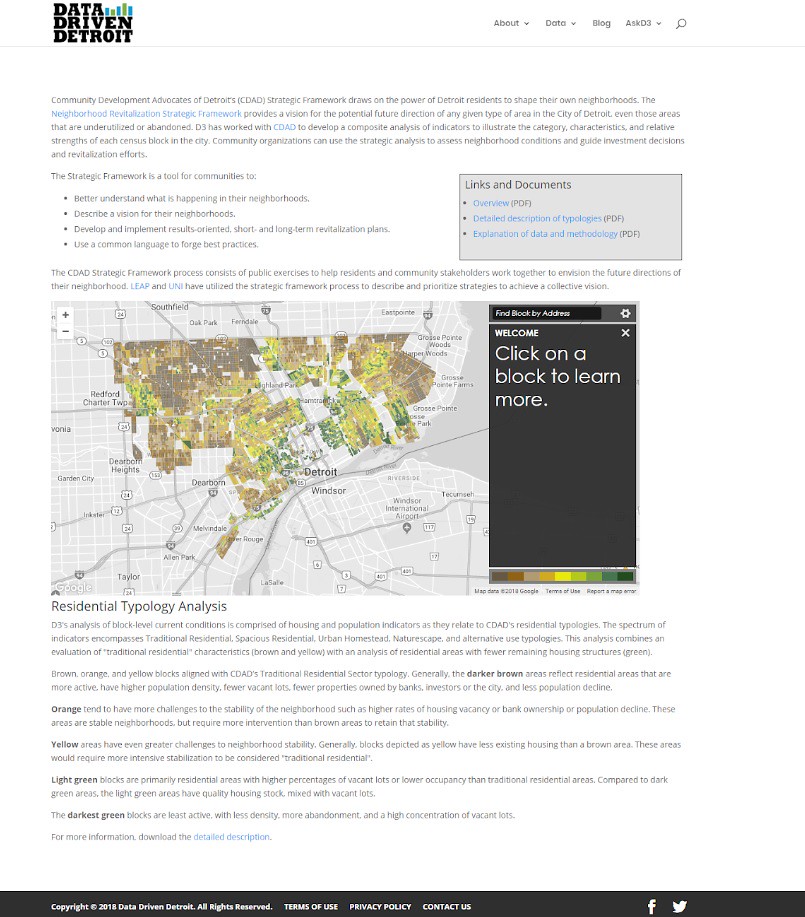
(Note: this past Sunday I wrote a 20-tweet (!), 657-word (!!) tweetstorm that was largely a response to some things from about a month ago. Yeah, I can hold onto a grudge. Anyway, here I'm offering an expanded version of the content from that tweetstorm, but also some elaborations that can provide more clarity and nuance. -Pete)
So last month I wrote a blog piece suggesting that the patterns of revitalization in Detroit and Chicago might be converging. The piece was in response to another piece written by Urbanophile Aaron Renn, in which he noted the factors behind the demographic challenges posed to Pittsburgh and Chicago. In the comments section, I said that Chicago was facing limits to revitalization that weren't readily recognized, while Detroit, in the early stages of its rebound, had fewer such limits. I suggested that perhaps there was a convergence between the two. Ultimately, I said, both cities were moving toward extreme bifurcation.
At least, that's what I thought I was saying. I took some flak from Chicagoans in particular who took exception to the Detroit/Chicago comparison. Their criticisms came in two forms:
1) You're crazy. There's no way Chicago and Detroit are comparable in any way.
2) Only a third of Chicago is struggling. The wealthiest third is booming, the middle third is stable.
Using the convergence framing that I did, and in the way I used it, the criticism was likely warranted. Chicago is far wealthier a city than Detroit is, and comparisons are almost irrelevant due to that fact.
This point was brought home by one commenter in particular who made a very valid point: I did a neighborhood typology for Chicago that splits the city into one of six community types: gentrified; gentrifying; frontline; stable prosperous; transitioning; and isolated. I even did a tidy table that shows how the community types compare with each other in a range of demographic factors. Some people disagreed with some aspects of the typology, but this particular commenter was disappointed I didn't do one for Detroit.
The commenter was right. I didn't do one. I tried to develop one for Detroit but there are no neighborhood or community-sized comparables in Detroit to Chicago's Community Areas in Detroit. Zip codes come closest but still miss a lot of nuance, so I chose not to use them.
Then I saw this by Data Driven Detroit:

They did a residential neighborhood typology similar to mine, but at the census block level. Here it is at closer inspection:

Here's how Data Driven Detroit characterized their typology work:
Generally, the darker brown areas reflect residential areas that are more active, have higher population density, fewer vacant lots, fewer properties owned by banks, investors or the city, and less population decline.
Orange tend to have more challenges to the stability of the neighborhood such as higher rates of housing vacancy or bank ownership or population decline. These areas are stable neighborhoods, but require more intervention than brown areas to retain that stability.
Yellow areas have even greater challenges to neighborhood stability. Generally, blocks depicted as yellow have less existing housing than a brown area. These areas would require more intensive stabilization to be considered "traditional residential".
Light green blocks are primarily residential areas with higher percentages of vacant lots or lower occupancy than traditional residential areas. Compared to dark green areas, the light green areas have quality housing stock, mixed with vacant lots.
The darkest green blocks are least active, with less density, more abandonment, and a high concentration of vacant lots.
Generally speaking, their analysis shows large amounts of vacant land (dark green) adjacent to the largely non-residential downtown, neighborhoods in various stages of transition beyond the city's zones of abandoned land, and areas of relative stability on the city's northeast and northwest sides. Keep in mind, however, that this typology is more about physical condition, and less about economic conditions. And, economically Detroit does lag Chicago, so stability there looks different from stability in Chicago. For those who know both cities well, the Pembroke neighborhood where I grew up on Detroit's Northwest Side might be a stable, black middle class area that's comparable to Chicago's Chatham, but it's not stable or prosperous in the way that maybe Portage Park is.
The point I was trying to make about Chicago and Detroit is that I view both cities are pioneers of a brand of revitalization/gentrification that might be unique to the Midwest/Rust Belt. Both cities, and many others in the Midwest/Rust Belt, had development patterns that were impacted by their response to the Great Migration in the early part of the 20th century, and they impact development patterns to this very day. Most Rust Belt cities, from Buffalo to St. Louis, gained significant numbers of black residents between 1910-1930 and again from 1950-1970, as blacks moved away from the Jim Crow South and toward the opportunity presented by plentiful manufacturing jobs. The near universal response by all of the Rust Belt cities was to "carve out" a section of town for blacks to live in, and leave it alone. This caused dramatically different development patterns than in today's "superstar" cities, which generally received far fewer black migrants (Boston and New York, to some extent, while Washington, D.C. is a notable exception. Most West Coast cities received even fewer black migrants).
I see Chicago as the leader here in adopting its pattern of segregation, and Detroit is following the same pattern. Chicago "gave up" much of the west and south sides for the new black arrivals and established other places in the city or suburbs. Detroit essentially "gave up" the entire city limits to its black residents and sprawled outward into suburbia. Ever since blacks emerged in Rust Belt cities, the response by white residents has been to move elsewhere -- and avoid the place you left with a passion.
This has created an interesting dynamic as both Chicago and Detroit entered the New Urban Future that took hold maybe 25-30 years ago. Chicago was able to make the switch and accommodate the mostly white, upper-middle-class-led revitalization of parts of the city because, in accordance with development practice, revitalization almost exclusively took place within formerly poor and working-class white ethnic neighborhoods. Detroit, however, was very late to that party, in large part because its poor and working-class white ethnic neighborhoods had already disappeared. In neither city was their much of an effort to touch neighborhoods with people of color.
Chicago
On to today. Chicago's inventory of former poor and working-class white ethnic enclaves has effectively run out. Developers face a choice: expand outward into neighborhoods with larger numbers of people of color, or build more densely in already hot neighborhoods. With some exceptions (Humboldt Park, parts of Pilsen), developers are choosing the latter.
This has serious ramifications. Building more densely in hot neighborhoods sounds good on the surface, but developers are likely approaching a ceiling (financial and physical) in those hot neighborhoods. Land acquisition costs go higher and higher. Development review and approval receives heightened scrutiny from city planners and elected officials. NIMBY residents organize against new development. And the price of housing has to go up to account for the additional headaches the developer receives. I think it's bringing revitalization efforts overall in Chicago to a halt.
At the same time much of Chicago is hollowing out. Blacks in particular are leaving the city in droves, especially on the west and south sides. Black population in Chicago fell by 17 percent between 2000 and 2010, and another nine percent from 2010 to 2016. Overall, Chicago's black population is down 24.7% since 2000 -- nearly 260,000 -- and showing no signs of slowing down.
Since the black withdrawal from Chicago is largely driven by black middle-class residents, motivated by poor school quality, crime, a lack of amenities or services, or poor job or growth opportunities, increasing concentrations of poorer residents with fewer choices are being left behind. So it appears Chicago is possibly headed toward extreme bifurcation: dense, wealthy concentration on the north lakefront, the Loop and near south side, and vacant concentrations of poor residents on the west and south sides. There are (and will be) concentrations of middle-class neighborhoods that sit between the affluence and poverty, but they will exist in various states of transition, potentially improving -- or collapsing..
Detroit
Meanwhile Detroit is in the very early stages of its own rebound. I was there 3 weeks ago and saw evidence of positive change. If you're from the D it's welcome, maybe even a little overwhelming. If you're not from there, it's the kind of normal city redevelopment you see in most cities today. Detroit just hadn't seen it.
That's because what's happening there, in my opinion, is more redemptive than revitalizing. I've written about this before, and I think what's happening is that people who once turned their back on Detroit are now willing to return and give it another look. The economy is fine there, but it's not super-heated and bringing thousands of people and jobs. Detroit is going through an emotional recovery as much as an economic one.
That being said Detroit has some good things going on in the downtown/Midtown/Corktown areas, but very little outside of that prospering core. The map above shows where the trouble lies. Immediately outside of downtown are broad expanses that are as vacant as they are occupied. Beyond this "empty quarter" are a ring of neighborhoods in transition surrounded by an outer ring of more stable neighborhoods. The loss of manufacturing jobs has made Detroit a mostly black working-class city, with people working in the service industry or no job at all, struggling, without much economic impetus moving them forward.
Detroit's current rebound, however, means that significant change could be on the horizon. The influx of middle-class and affluent people that the city has witnessed over the last five years means that Detroit could eventually develop its own bifurcation features, like Chicago -- but with a twist. My guess is that the D will expand outward and build up its "empty quarter" until it comes up against the transitional neighborhoods in the secondary and tertiary rings.
In this context Detroit's "empty quarter" is an asset, for two reasons: 1) new visions of large scale walkable urbanism can be considered, remaking large swaths of the city; and 2) less displacement/disruption and resulting conflict. My guess on where that might happen? I'd say the east riverfront, Poletown East, Milwaukee Junction, North End, Virginia Park, Woodbridge, LaSalle Gardens, the Southwest Side. Areas with considerable vacancy, but just enough urban fabric to form the foundation.
It won't happen soon. There's not enough juice (or time) in this economic cycle for it to happen in Detroit soon. But I'd bet developers are already buying lots and placing bets on areas that will build out over the next 10-15 years.
Here's where things get tricky. I can foresee a future where Detroit's expansive growth on largely empty land outside of downtown will be hailed, but ultimately stalled as it reaches intact neighborhoods. Chicago's vertical growth will be pilloried for having little influence in poor areas.
All because both Chicago and Detroit are notable for their extreme avoidance of revitalization in black neighborhoods, a legacy of segregation patterns established by the Great Migration more than 100 years ago.
This piece originally appeared on The Corner Side Yard.
Pete Saunders is a Detroit native who has worked as a public and private sector urban planner in the Chicago area for more than twenty years. He is also the author of "The Corner Side Yard," an urban planning blog that focuses on the redevelopment and revitalization of Rust Belt cities.
Photo: A block in Detroit's Virginia Park neighborhood. It has the kind of urban fabric that might be poised to return in the D. From modeldmedia.com












